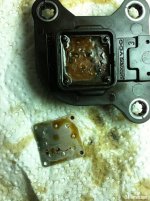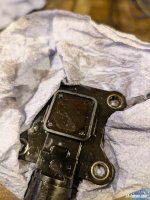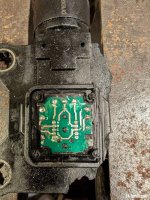axelleveau
Member
Intro:
I guess most N52 owners will know about the ESS and a significant amount had to deal with a failing one. In my case I had a perfectly working OEM one which I replaced when doing a cam cover and gasket refresh as it was showing signs of oil in the plug. Did not feel like paying the extortionate £400 that BMW asks for it, and not even the £100-200 from reliable brands so went for a £55 sensor on Autodoc. Well, it lasted 18months until it started messing up (car running on throttle with slow/jerky response), showed lots of oil in the connector and a couple errors in the ECU... And this is were the search started...
I will detail what I have gone through, tried and learn so far in the order I did even though it would make more sense to go through Failure-Search-Fix...

1-The attempt:
After doing some reading online, particularly forums about E90 ownership I confirmed the cause of failure and source of oil is internal. The plate used to "seal" the sensor lets oil get in which kills the sensor and comes out in the connector. So here is what I did: Buy a cheap sensor for the measly price of £25, praying it is not DOA and making it more robust because after all the electronics should be simple and there is a common failure more in 100% of cases so a cheap sensor is less money lost if I fail.
The solution? I stuffed RTV along the edges and smeared some across the entire plate after brushing with a wire brush and decreasing the surfaces. The prep and the smear has been done to minimize chances of oil sipping under the sealant. First application I did it was pealing from the metal plate at the edges so I tear it off and re-did everything.

2-Additional info:
While discussing this with a colleague I was looking for online images, came across a slightly different looking sensor and realized a US based company claims to have fixed the issue: https://www.dormanproducts.com/p-77342-917-030.aspx
Unfortunately at the price they ask, especially once imported, I would still go for a cheaper route especially as feedback on forums is not great, people claim those still take on oil and from looking at the pictures it does not seem they have fully sealed the sensor.
If I was entrepreneurial I would maybe go after a Chinese company that makes those and work on a fully sealed design, maybe through a laser or ultrasonic welded plate but like fully welded on the edge, then sell for about £150 with a lifetime warranty...
Why do it with my easy fix and not a more refined plastic welding? Because the sensor (at least the one I bought) is made of a "fancy" type of poly-amide with high melting point and oil resistance. I only have PVC and PP at hand and doing a weld with those would not work.
3-Where I am at now:
So, my putty sensor is now in my car, engine started and revved and all seem good with no error code thrown. Unfortunately I slightly damaged the seal around the sensor and have a weak thread on one of the cam cover screws but that can be dealt with if I see oil leaks. I will basically use the car as usual and figure out how long things last. Unfortunately I am a sample of 1 so best I can do is have a go at it and resuscitate some interest in the community to find a robust fix. If my sensor fails quickly again I will certainly try another way of sealing it, maybe epoxy, maybe removing and re-installing the blanking plate with RTV under it. Difficulty is to find something good but at no risk to the engine if it fails.
4-Autopsy:
After swapping the sensor I decided to dig into my old one and see if I see the same signs as some of the E90 forums. Well just from pressing on the steel plate I get oil coming out. After taking the plate out I met with a hard potting material which also lets oil out when pressed.

I then butchered the sensor to go under that material and the PCB is oily and oil comes out when pressed. The outrageous truth about those sensor is they seem to simply be hall effect chip with a PCB to connect to the outside so they are a money printer for BMW. I will de-solder the PCB and confirm when I have time. All of this confirms that taking the blanking plate out to improve sealing would be a fair way to go if things fail with my first attempt.

I guess most N52 owners will know about the ESS and a significant amount had to deal with a failing one. In my case I had a perfectly working OEM one which I replaced when doing a cam cover and gasket refresh as it was showing signs of oil in the plug. Did not feel like paying the extortionate £400 that BMW asks for it, and not even the £100-200 from reliable brands so went for a £55 sensor on Autodoc. Well, it lasted 18months until it started messing up (car running on throttle with slow/jerky response), showed lots of oil in the connector and a couple errors in the ECU... And this is were the search started...
I will detail what I have gone through, tried and learn so far in the order I did even though it would make more sense to go through Failure-Search-Fix...

1-The attempt:
After doing some reading online, particularly forums about E90 ownership I confirmed the cause of failure and source of oil is internal. The plate used to "seal" the sensor lets oil get in which kills the sensor and comes out in the connector. So here is what I did: Buy a cheap sensor for the measly price of £25, praying it is not DOA and making it more robust because after all the electronics should be simple and there is a common failure more in 100% of cases so a cheap sensor is less money lost if I fail.
The solution? I stuffed RTV along the edges and smeared some across the entire plate after brushing with a wire brush and decreasing the surfaces. The prep and the smear has been done to minimize chances of oil sipping under the sealant. First application I did it was pealing from the metal plate at the edges so I tear it off and re-did everything.

2-Additional info:
While discussing this with a colleague I was looking for online images, came across a slightly different looking sensor and realized a US based company claims to have fixed the issue: https://www.dormanproducts.com/p-77342-917-030.aspx
Unfortunately at the price they ask, especially once imported, I would still go for a cheaper route especially as feedback on forums is not great, people claim those still take on oil and from looking at the pictures it does not seem they have fully sealed the sensor.
If I was entrepreneurial I would maybe go after a Chinese company that makes those and work on a fully sealed design, maybe through a laser or ultrasonic welded plate but like fully welded on the edge, then sell for about £150 with a lifetime warranty...
Why do it with my easy fix and not a more refined plastic welding? Because the sensor (at least the one I bought) is made of a "fancy" type of poly-amide with high melting point and oil resistance. I only have PVC and PP at hand and doing a weld with those would not work.
3-Where I am at now:
So, my putty sensor is now in my car, engine started and revved and all seem good with no error code thrown. Unfortunately I slightly damaged the seal around the sensor and have a weak thread on one of the cam cover screws but that can be dealt with if I see oil leaks. I will basically use the car as usual and figure out how long things last. Unfortunately I am a sample of 1 so best I can do is have a go at it and resuscitate some interest in the community to find a robust fix. If my sensor fails quickly again I will certainly try another way of sealing it, maybe epoxy, maybe removing and re-installing the blanking plate with RTV under it. Difficulty is to find something good but at no risk to the engine if it fails.
4-Autopsy:
After swapping the sensor I decided to dig into my old one and see if I see the same signs as some of the E90 forums. Well just from pressing on the steel plate I get oil coming out. After taking the plate out I met with a hard potting material which also lets oil out when pressed.

I then butchered the sensor to go under that material and the PCB is oily and oil comes out when pressed. The outrageous truth about those sensor is they seem to simply be hall effect chip with a PCB to connect to the outside so they are a money printer for BMW. I will de-solder the PCB and confirm when I have time. All of this confirms that taking the blanking plate out to improve sealing would be a fair way to go if things fail with my first attempt.
